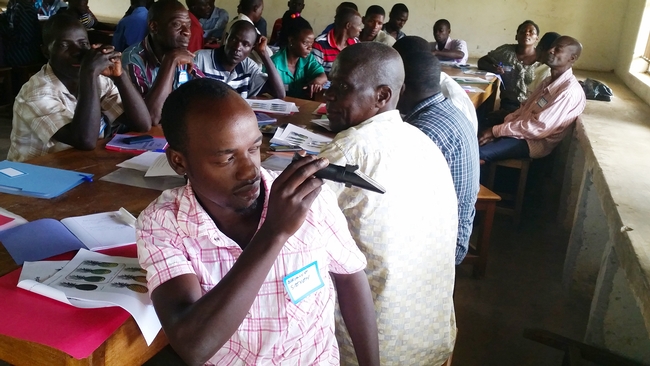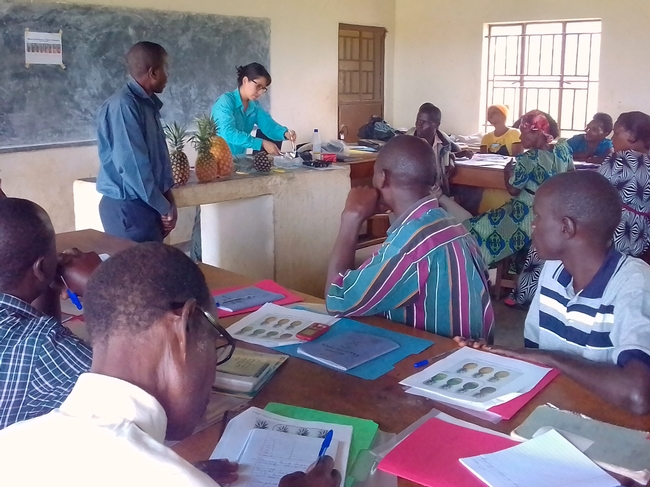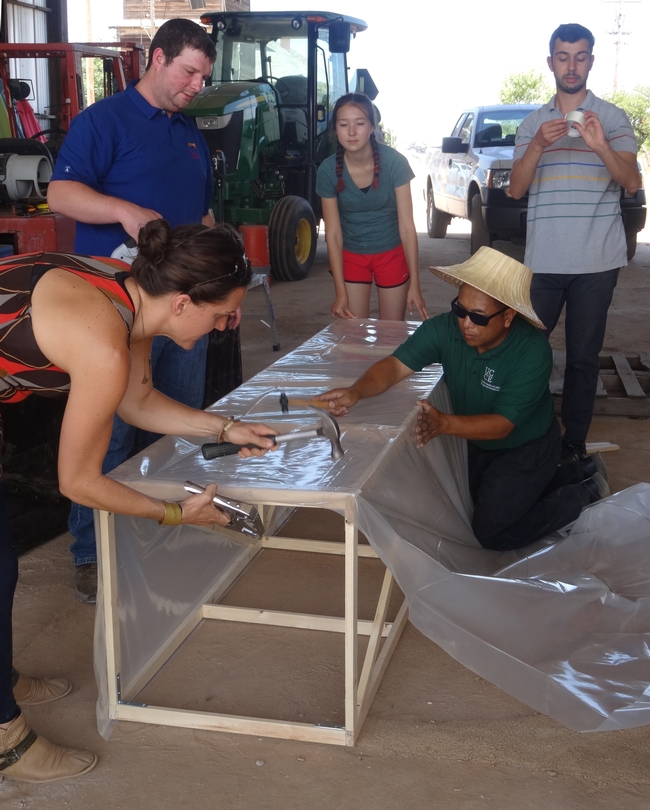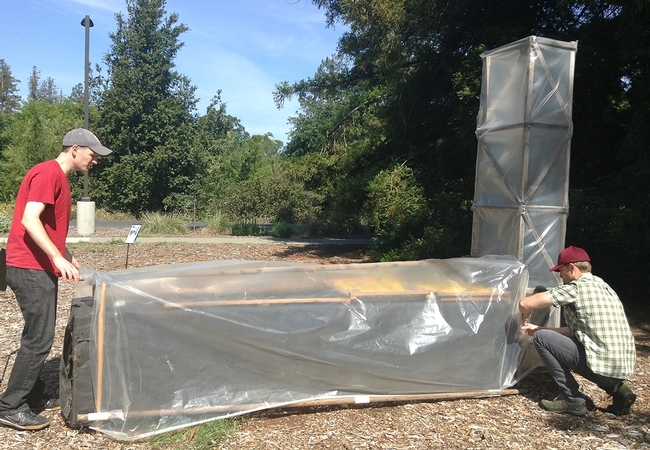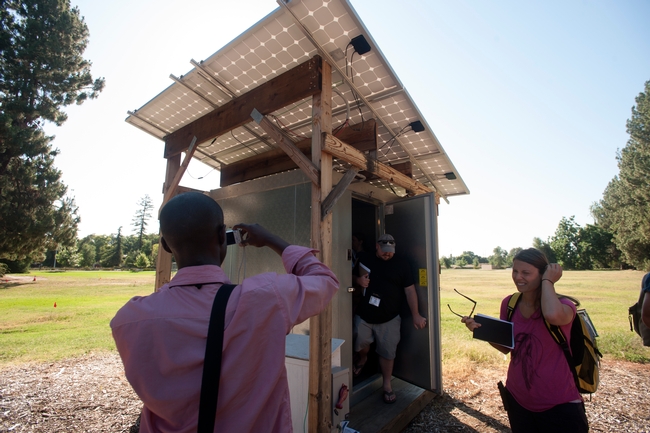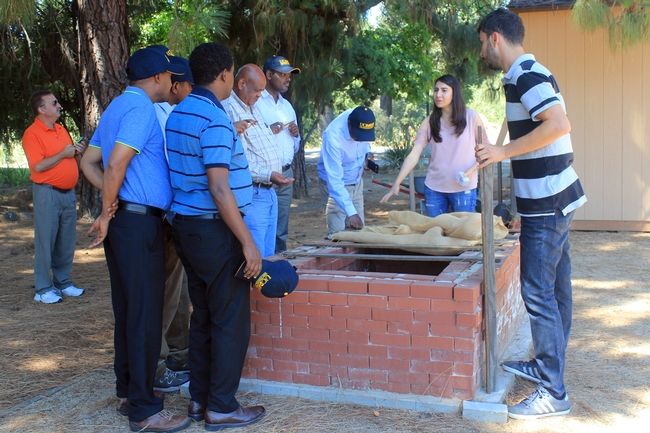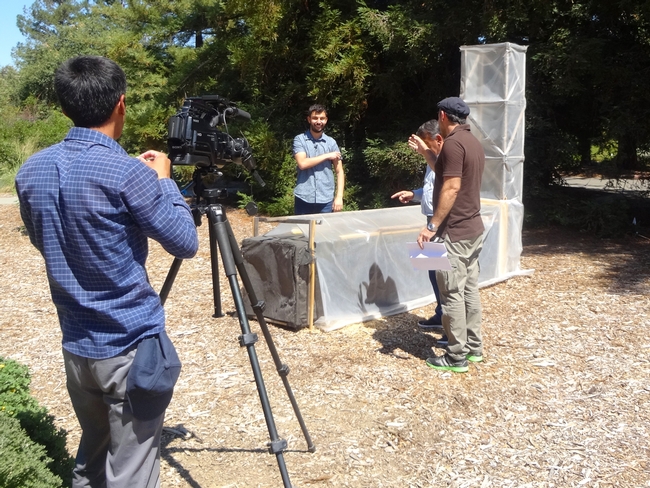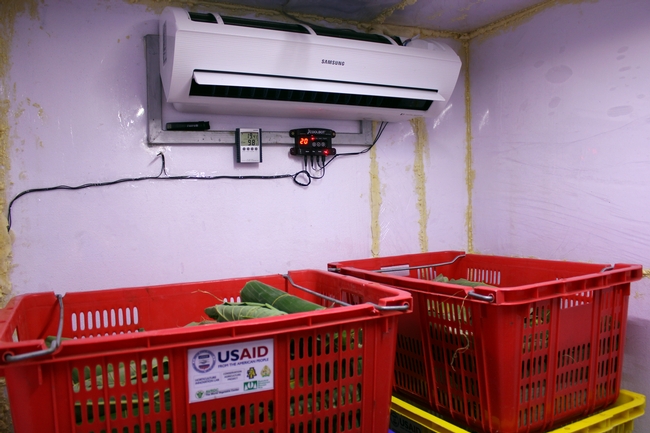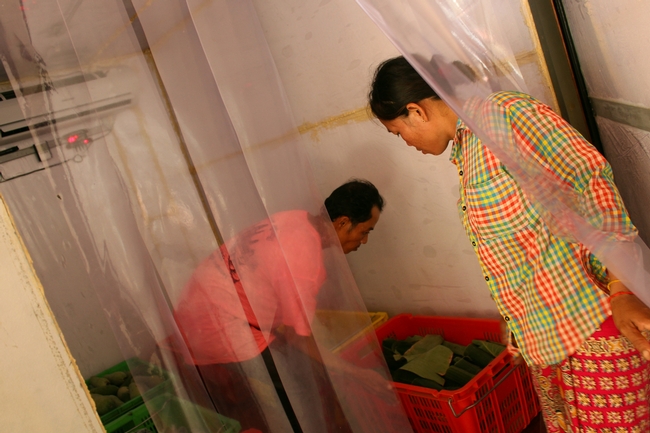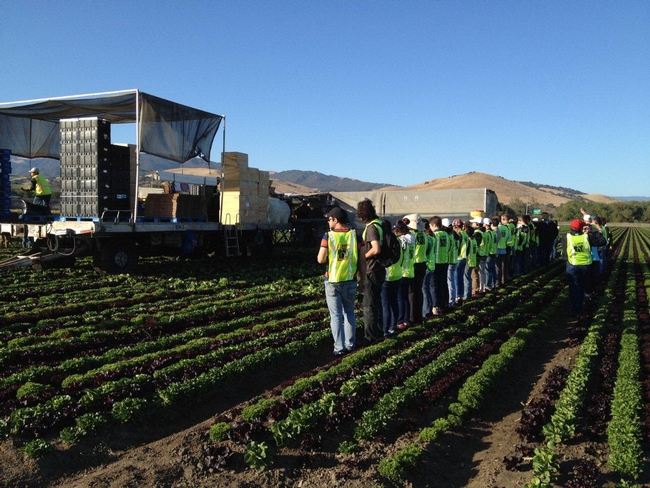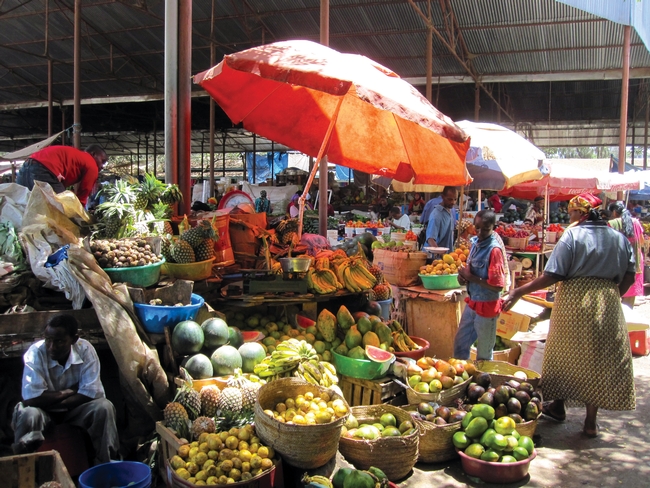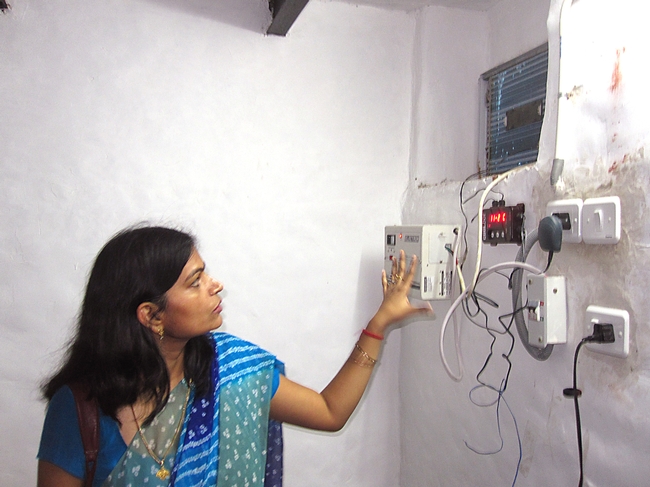Posts Tagged: Postharvest
Connecting with farmers over pineapple postharvest practices
At the end of a long year, sometimes it helps to reconnect with what motivates your work.
For Karin Albornoz — a Ph.D. student who works in the Diane Beckles Lab at UC Davis on molecular biology related to tomato postharvest chilling injury — that means getting out into the world to work directly with small-scale farmers.
"I spend so much time in the lab," she said. "Sometimes I spend a whole day in the lab extracting RNA or writing a paper. This reminds me why I am doing this work: to make a real-world impact."
Just over a week ago, she returned from a trip to Uganda where she did exactly that. In partnership with a local organization called Ndibwami Integrated Rescue Project (NIRP), Albornoz shared her expertise with farmers through several hands-on workshops about improving harvest practices and postharvest handling of pineapple, passion fruit and tomatoes. Her work was supported by the Horticulture Innovation Lab, an international agricultural research program led by UC Davis with funding from the U.S. Agency for International Development as part of Feed the Future, the U.S. government's global hunger and food security initiative.
Though Albornoz has worked with rural farmers before, this was her first time working in Africa.
"Everywhere I looked, things were growing. There were people working in the field, women cooking, and everyone was working with food," she said. "I know there's a lot of stigma – when you talk about Africa, you see people's faces change and they're thinking about things like drought and famine and starving children. But what I saw doesn't fit that stereotype. The challenges they are facing seem to be about not having access to opportunities."
The workshops she led are part of the NIRP organization's efforts to connect farmers with more lucrative markets that pay higher prices for quality produce.
In this 2-minute video, Karin Albornoz visits a pineapple farm, leads a pineapple training and discusses next steps for this project led by NIRP in Uganda. The video clips and photos were taken by Karin while she was working and edited by Hallie Casey for the Horticulture Innovation Lab.
For months, Albornoz has been in contact with NIRP and making plans for the farmer workshops. She prepared postharvest handling manuals for each crop — pineapple, passion fruit and tomato — and asked questions to better understand local resources and the farmers' existing knowledge.
During her 2 weeks in Uganda, she visited farmers' fields and led three full-day workshops. The first workshop for about 50 farmers focused on pineapple — starting with understanding local quality parameters for this fruit, then best practices for harvesting, sanitation, storage and transportation. The second workshop was focused on tomato, with a similar structure, and the third workshop on passion fruit.
Her favorite moment? The farmers' first chance to use a refractometer, to measure soluble solids and learn about sugar levels in the fruit. The refractometers were part of a small toolkit the organization will continue to use.
"They were excited to handle this device and see, in numbers, how the sugar levels of the fruit changed depending on the stage of maturity," she said. "Everyone in the room had a chance to try it."
The experience reinforced her commitment to working with farmers and solving agricultural problems.
"A major mistake is to think that you are going just to train or teach other people because those people are always going to end up teaching you too," Albornoz said. "I made a promise to myself years ago, a personal commitment to working with people in vulnerable situations. I have to do this. Working in agriculture can be a very powerful tool to have an impact in the world."
As Karin's mentor and an Associate Professor in the UC Davis Department of Plant Sciences and Agricultural Experiment Station, Diane Beckles supported Karin's work outside of the lab and views such an experience as important to scholarly development.
"Something magical happens when we teach and engage in outreach," Beckles said. "We often deepen our understanding of what we are teaching, and interacting and engaging with others changes us in that process. It alters how we view and think about science in a way that is positive and rewarding, even though it is not easily quantified."
More information:
- More about Trellis Fund projects with the Horticulture Innovation Lab
- Pineapple recommendations from the UC Postharvest Center
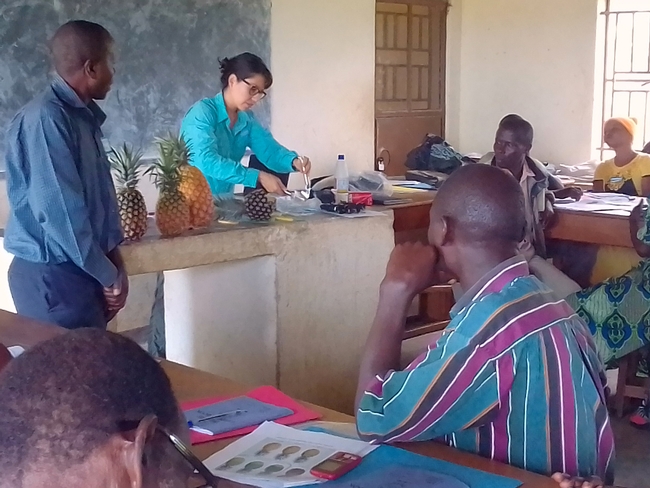
thumbnail: Karin Albornoz leads a workshop in postharvest handling of pineapple in Uganda.
Explore tools that UC researchers use with smallholder farmers around the world
Planted in a corner of the UC Davis campus is a display of technologies and vegetable crops that researchers with the Horticulture Innovation Lab have been using with farmers in Africa, Asia and Central America. Led by UC ANR's Elizabeth Mitcham in the UC Davis Department of Plant Sciences, this program harnesses the agricultural expertise of a network of U.S. university researchers to improve how farmers in developing countries grow fruits and vegetables.
More often than not, the learning goes both ways: Adapting solutions for farmers on another continent can spark ideas that might be useful back home too.
So while the Horticulture Innovation Lab's Demonstration Center was built to showcase international work to campus visitors, you wouldn't be the first to wonder, “Would this technology work on a California farm too?”
Recently a team from UC Cooperative Extension in Fresno County — led by Ruth Dahlquist-Willard, UC Cooperative Extension advisor for small farms in Fresno and Tulare counties — worked with the Horticulture Innovation Lab to learn how to build one of these technologies, to try out with local farmers.
The low-cost technology they built, called a “chimney solar dryer,” combines continuous air flow with solar heat to dry fresh produce more efficiently than a traditional solar dryer. It was designed by the innovative duo Michael Reid and Jim Thompson, both emeritus specialists with UC Cooperative Extension who have worked on multiple inventions with the Horticulture Innovation Lab. The chimney solar dryer is usually built with basic materials, such as plywood, dark plastic, clear plastic, and food-grade mesh. Read more about how the chimney solar dryer can help farmers add value to crop surplus (PDF).
Here is a quick look at a couple of other technologies that visitors can see at the demonstration center:
This solar-powered cold room uses a tool designed by an American farmer, called a CoolBot. In a well-insulated room, a CoolBot can trick a household air conditioner into bringing temperatures down low enough for cool storage of fresh produce. Cooling fruits and vegetables soon after harvest from the field can reduce postharvest losses and extend shelf life. So far teams with the Horticulture Innovation Lab have used the CoolBot with farmers in Tanzania, Zambia, Uganda, Thailand, Cambodia, Bangladesh, India and Honduras.
Read more about how this farmer's invention is reducing postharvest losses around the world.
The zero-energy cool chamber (known as ZECC) is a simple structure built from brick and sand that can help cool fresh produce, in conditions where evaporative cooling is effective. By regularly wetting the sand and brick, farmers or even marketers can keep the temperatures low and the humidity high for fresh produce such as leafy greens. Researchers with the Horticulture Innovation Lab have been testing what specific conditions — such as hot, arid climates with easy access to water — make this tool effective for farmers to use to cool their fresh fruits and vegetables.
More information about the ZECC is available from the UC Postharvest Technology Center.
Recent visits to the Horticulture Innovation Lab's demonstration center have come in many shapes and sizes — from people walking by who stopped to read some of the signs, to group activities planned in advance. Recent tours of the center have included a delegation of deans from agricultural colleges in Ethiopia, a television news crew from Tajikistan and high school students from California learning about innovation and human-centered design.
Next time you're on the UC Davis campus, consider dropping by the Horticulture Innovation Lab demonstration center. You can find it on the campus map, or contact the team for a more focused tour.
Maybe it will spark an innovative idea that you can use in your fields?
More information:
- More recent blog posts about the Horticulture Innovation Lab Demonstration Center
- Explore the African vegetables on display
- Learn more about the technologies on display
- Get updates from the Horticulture Innovation Lab's email newsletter
Led by UC Davis, the Horticulture Innovation Lab is funded by the U.S. Agency for International Development (USAID) as part of Feed the Future, the U.S. government's global hunger and food security initiative.
How one farmer’s invention is reducing postharvest losses around the world
In many developing countries, more than half of all fruits and vegetables are never eaten, but instead are lost, damaged or spoiled after harvest. These “postharvest” losses can mean that farmers need to sell their fresh produce as soon as it is harvested for whatever price they can get, before they lose the crops that represent investments of labor, water, and agricultural inputs. Improving how fruits and vegetables are handled after harvest can significantly prolong freshness — and cooling is key.
“The three most important aspects of postharvest handling are: temperature, temperature, temperature,” said Michael Reid, UC Cooperative Extension postharvest specialist who works with the Horticulture Innovation Lab at UC Davis. “In the developing world in particular, affordable cooling technology is mostly absent.”
Cooling can be expensive — even for American farmers
As a farmer in upstate New York, Ron Khosla knew this problem too well. His vegetable crop was spoiling too quickly, but he could not afford to buy a walk-in cooler for his small farm. So he invented a solution: a small electrical device he called a CoolBot that tricks an air conditioner into getting colder without freezing over, turning a well-insulated room into a cold room at lower costs than refrigeration.
“I was hoping for a cheap, DIY solution that I could maintain. But mostly I just needed to keep my leafy greens and strawberries cold,” Khosla said.
Khosla's CoolBot invention caught the eye of postharvest researchers, including Reid, who saw it in action on farms in California and decided to try using it in developing countries too.
CoolBot goes global with the Horticulture Innovation Lab
In one of his first projects with the Horticulture Innovation Lab (a program led by UC Davis with funding from the U.S. Agency for International Development), Reid partnered with agricultural scientists from Uganda, Honduras and India to test the CoolBot in their climates. The four scientists also tested different local materials as insulation for each of the cold rooms.
Since that first project, the Horticulture Innovation Lab has tested CoolBots for farmer cold storage in Tanzania, Zambia, Uganda, Thailand, Cambodia, Bangladesh, India and Honduras.
Jane Ambuko of the University of Nairobi is another Horticulture Innovation Lab partner who has worked with the CoolBot. She received a grant to pilot this technology with mango farmers for a program called the Kenya Feed the Future Innovation Engine. Her project was featured on an NTV Food Friday news segment about the CoolBot earlier this month.
“I see the CoolBot making a whole lot of difference,” Ambuko said during a TEDxNairobi speech. “But for it to make that desired difference we have to make it cost-effective and affordable for the smallholder farmers.”
Adapting, troubleshooting and scaling up
In many places, the most expensive part of a CoolBot-equipped cold room is the structure for the insulated room, but both Reid and Khosla expect foam building materials to become more widely available and affordable.
In the meantime, Khosla's small business has been growing — selling to not only farmers, but also florists, micro-brewers, and other artisanal food businesses. Now with six employees, the company has sold more than 27,500 CoolBots in 51 countries.
“I'm thrilled and so grateful to be a part of helping lots of people. Working with USAID has gotten us known in other countries, and I'm looking forward to the day when we have enough in-roads in India and Africa where we can work directly with farmers there,” Khosla said. “People didn't believe the CoolBots worked at first. But now we get the most amazing letters from people whose businesses have doubled or quadrupled. Good postharvest care makes such a difference. Once they try it, then they see.”
A previous version of this article appeared in the newsletter for Feed the Future, the U.S. government's global hunger and food security initiative, and also in the Horticulture Innovation Lab blog.
Event - Sustainable solutions and extending California's agricultural expertise to the world: The UC Global Food Initiative and UC Blum Centers will host a Global Food Summit on Sustainable Solutions, May 5-6 at UC Irvine. Elizabeth Mitcham, director of the Horticulture Innovation Lab and UC Cooperative Extension postharvest pomologist at UC Davis, will be speaking about technology transfer for horticulture-related technologies such as the CoolBot, seed drying beads, UC Davis-designed chimney solar dryer, pest-exclusion nets, and other tools the program adapts to the needs of farmers in developing countries. She will also be on a panel with two other UC Davis-based directors of Feed the Future Innovation Labs (UC Davis leads five Feed the Future Innovation Labs with funding from USAID — more than any other university). More info about this event.
UC Davis Postharvest Technology Center offers first-ever produce professional certificate program
It takes a lot of knowledge and training to successfully handle produce from farm to plate. Wouldn’t it be nice if there were a mechanism that helped produce industry employers recognize qualified applicants and helped applicants validate their postharvest qualifications?
Now there is, thanks to the UC Davis Postharvest Technology Center’s new Produce Professional Certificate Program, the first of its kind in the world. Led by a cadre of the most respected experts in postharvest technology, the certificate program covers everything from safety, new technologies, physiology, harvesting, cooling, transportation, ripening, marketing fresh produce and more.
“It’s fantastic,” said Leo Kelly, a product development specialist with Monsanto Vegetable Seeds who focuses on developing tomatoes, peppers, melon, broccoli and other commodities with improved traits like flavor, nutrition, color and convenience. When the Postharvest Technology Center first started offering the Professional Certificate Program in early 2013, Kelly was among the first in line.
“I had attended some of their other courses and I really admire the instructors’ knowledge and expertise,” Kelly said. “This certificate program gives me a deeper understanding of the science behind postharvest technology, the reason you do the things you do, like store tomatoes at a different temperature than onions.”
Kelly has a Ph.D. in cereal biochemistry, 20 years experience in the food industry, and five years experience with Monsanto. And, he says, there is still so much more to learn.
The program allows participants to customize their curriculum through an a-la-carte menu of classes in addition to three core classes — the Postharvest Technology Short Course, the Produce Safety Course and either the Fruit Ripening and Retail Handling Workshop or the Fresh Cut Products Workshop. Some of the customized classes can be taken online and you have four years to finish.
“That’s very convenient for working people like me,” Kelly said. “You can keep your job and get the education.”
The program is designed for anyone in the fresh produce industry, no matter their specialty or level of experience. Postharvest technology involves people all along the supply chain — growers, shippers, packers, retail and others — and Kelly says participants benefit from that diversity.
“You network with people throughout the industry and from all over the globe,” Kelly said.
The produce professional certificate program will help employers, job-seekers and anyone who wants to expand their postharvest expertise, said Beth Mitcham, director of the Postharvest Technology Center and a postharvest biologist and Cooperative Extension specialist with the Department of Plant Sciences at the University of California, Davis.
“When produce industry employers are hiring, candidates with a Produce Professional Certificate will have an advantage over other candidates,” Mitcham said. “When you know the candidate has learned and demonstrated knowledge of best practices for produce handling, you’re confident they will be an assist to your company.”
Depending on which courses you chose, the certificate program will cost about $7,500 over four years. For more details, check out the Postharvest Technology Center website at http://postharvest.ucdavis.edu/ or contact the center staff at (530) 752-6941 or postharvest@ucdavis.edu.
Media contacts:
- Diane Nelson, UC Davis College of Agricultural and Environmental Sciences, (530) 752-1969, denelson@ucdavis.edu
- Beth Mitcham, UC Davis Postharvest Technology Center, (530) 752-7512, ejmitcham@ucdavis.edu
Hot days, cool rooms, tasty vegetables
I'll admit that one of my favorite things to do on a hot day is to walk into an air-conditioned room. That burst of cool air in those first moments can be so refreshing.
It turns out I'm not alone — fruits and vegetables like to be cool on hot days too.
Controlling temperature helps regulate the aging process of a fruit, along with its water loss and microorganism growth. Storing fruits and vegetables at their lowest safe temperatures means they taste better and last longer.
To help us know the best ways to store fresh produce at home, the UC Davis Postharvest Technology Center offers a free PDF poster Storing Fresh Fruits and Vegetables for Better Taste, which includes tips for different fruits and vegetables, from avocado to watermelon.
Knowing the right temperature is only part of the battle for farmers, who are responsible for the first links in the cold chain. Getting produce out of the sun and cool for storage can be a big challenge — and an expensive one.
But a farmer in New York, Ron Khosla, answered this challenge with a tool that can help make cooling produce less expensive for small-scale farmers. He created the CoolBot, a micro-controller that turns a well-insulated room with a regular air conditioner into a commercial cool room for storing fruits and vegetables.
Just as small-scale American farmers struggle with affordable cooling, so do smallholder farmers elsewhere in the world. Researchers with the Horticulture Collaborative Research Support Program (Horticulture CRSP) decided to test the CoolBot device, first at the UC Davis Student Farm and then with farmers in India, Honduras and Uganda.
Indeed, the CoolBot-equipped rooms worked, and the program is building more in Bangladesh right now. But there is a catch: Farmers must have access to reliable grid electricity for a cool room like this to work. To address this problem, the CoolBot in Uganda was powered with solar photovoltaic cells, but that led to another set of challenges — expensive equipment and fear of theft.
So how do you effectively cool vegetables, hot from a field, without grid electricity? A solution that is low-cost, effective and off-grid has not been found yet. In an effort to uncover such a solution, Horticulture CRSP will soon be launching a technology design competition that asks that very question. Can you answer this challenge?

